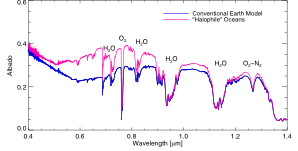2013 Annual Science Report
 VPL at University of Washington
Reporting | SEP 2012 – AUG 2013
VPL at University of Washington
Reporting | SEP 2012 – AUG 2013
The Nature and Detectability of Astronomical Biosignatures
Project Summary
In this project VPL team members explore the nature and detectability of biosignatures, global signs of life in the atmosphere or on the surface of a planet. This year we completed comprehensive modeling work that explores the potential for non-biological generation of oxygen and ozone in early Earth-like atmospheres, which could result in a “false positives” for photosynthetic life. We also explored the detectability of molecular dimers, especially O2-O2 as potentially easier to detect biosignature gases for transit transmission observations.
We also calculated maximum methane fluxes from the geological process of serpentinization, as a potential false positive for life, and looked at the nature and detectability of non-photosynthetic pigments as potential biosignatures for life on exoplanets. We also started work to develop new, more generalized biosignatures via measurement of thermodyamic and kinetic anomalies in planetary atmospheric compositions that are associated with life. We complemented this theoretical work with field work in caves dominated by sulfur-bacteria, to understand isotopic processing of sulfur by life, as a potential biosignature for life on Mars, or for planets with sulfur-domianted biospheres.
Project Progress
In this task, we seek to understand the processes that lead to a biogenic gas, isotope of a gas, pigment or disequilibrium state becoming a biosignature, and explore the potential for false positives and the detectability of these signatures in realistic planetary spectra. With our new transit transmission model (Misra et al., submitted) we have shown the absorption features from the O2-O2 dimer at 1.06 and 1.27μm can be used as a biosignatures and may be detectable by JWST, even for Earth-sized transiting planets orbiting M dwarf stars (Misra et al., 2013, in press). In other biosignature research, Domagal-Goldman, Segura, Claire and Meadows completed a comprehensive study into the generation of abiotic false positives for ozone for early Earth-type planets in orbit around M dwarf stars, and explored the detectability and means to discriminate these false positives from true biosignatures (Domagal-Goldman, in prep).
Segura and colleagues calculated a possible maximum methane production for the abiotic process of serpentinization, for a planet of Earth-like composition (Guzmán-Marmolejo et al., 2013). Serpentinization is the main abiotic process that generates methane on Earth, as may be the case for potentially habitable planets around other stars. Their calculations indicate that the surface flux of methane by serpentinization may not exceed 109 molecules/cm2/s, and once released into the atmosphere, methane concentrations are maintained at less than 500 ppm for CO2-rich atmospheres.
Schwieterman and Meadows collaborated with Cockell of the UK Center for Astrobiology to explore the detectability of non-photosynthetic pigments, especially for halophiles, in an Earth-like planet’s disk-averaged spectra (Schwieterman et al., in prep). Non-photosynthetic pigments may produce alternative surface reflectance biosignatures to putative photosynthetic vegetation analogs. They used the VPL’s 3D spectral Earth model to explore the detectability of the surface biosignature produced by pigmented halophiles that are widespread on an Earth-analog planet. They found that peaks in the wavelength-dependent albedo of the pigment can be preserved in the planet spectrum after convolution with absorption and scattering effects from the atmosphere. Bright pigments would also increase the contrast of the continuum with absorption features from gases such as water vapor and oxygen, potentially increasing the detectability of these spectral features
Catling, with Robinson and new graduate student Krissanson-Totton initiated a study of thermodynamic disequilibrium in planetary atmospheres. A first step in understanding physical entropy in planetary atmospheres resulted in a paper that improved our generalized understanding of the origin and maintenance of atmospheric vertical temperature and pressure structures (Robinson and Catling, 2013; see also the Climate and Evolution task report). This understanding can also be used as an initial framework to improve retrieval of exoplanetary atmospheric properties and structure.
Conrad participated in cave field work in order to look for detectable gas biosignatures proximal to fractures in the surface over the caves. The field site was in Tabasco, MX at a high sulfur cave (Cueva de Villa Luz) such as one might postulate could exist on Mars after the transition to a dry era of high sulfate deposition on the surface. Samples of the air both in and out of the cave were collected to determine whether isotopic signatures were retained in the noble gases. In addition, samples of the rocks, any water and organisms within the cave were collected to study the partitioning of sulfur and hydrogen in the gas, liquid, rock and biota. Analyses are on going in Conrad’s new state-of-the art noble gas analytical facility at NASA/GSFC.

Publications
-
Guzmán-Marmolejo, A., Segura, A., & Escobar-Briones, E. (2013). Abiotic Production of Methane in Terrestrial Planets. Astrobiology, 13(6), 550–559. doi:10.1089/ast.2012.0817
-
Line, M. R., Wolf, A. S., Zhang, X., Knutson, H., Kammer, J. A., Ellison, E., … Yung, Y. L. (2013). A SYSTEMATIC RETRIEVAL ANALYSIS OF SECONDARY ECLIPSE SPECTRA. I. A COMPARISON OF ATMOSPHERIC RETRIEVAL TECHNIQUES. The Astrophysical Journal, 775(2), 137. doi:10.1088/0004-637x/775/2/137
-
PROJECT INVESTIGATORS:
-
PROJECT MEMBERS:
David Catling
Project Investigator
Antigona Segura-Peralta
Project Investigator
Mark Claire
Co-Investigator
Pamela Conrad
Co-Investigator
Nicole Evans
Co-Investigator
Joshua Krissansen-Totton
Co-Investigator
Amit Misra
Co-Investigator
Tyler Robinson
Co-Investigator
Edward Schwieterman
Co-Investigator
-
RELATED OBJECTIVES:
Objective 1.1
Formation and evolution of habitable planets.
Objective 1.2
Indirect and direct astronomical observations of extrasolar habitable planets.
Objective 4.1
Earth's early biosphere.
Objective 7.2
Biosignatures to be sought in nearby planetary systems


